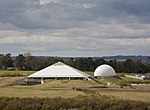Morestead

Morestead is a village and former civil parish, now in the parish of Owslebury, in the Winchester district, in Hampshire, England. It is in the South Downs, about 3 miles (5 km) southeast of Winchester. In 1931 the parish had a population of 96. On 1 April 1932 the parish was abolished and merged with Owslebury.The village lies on rising downland adjacent to the ancient Roman road from Portchester to Winchester. Morestead is predominantly a farming community and there are racehorse training stables. The ancient Parish Church has no known dedication. Parts of the structure date from around 1150 while the font dates from around 1200. The church underwent an extensive rebuild in 1873.Next to the church is the former rectory built in the mid 1830s.
Excerpt from the Wikipedia article Morestead (License: CC BY-SA 3.0, Authors, Images).Morestead
Belmore Lane, Winchester Owslebury
Geographical coordinates (GPS) Address Nearby Places Show on map
Geographical coordinates (GPS)
| Latitude | Longitude |
|---|---|
| N 51.0262 ° | E -1.2746 ° |
Address
Belmore Lane
Belmore Lane
SO21 1NB Winchester, Owslebury
England, United Kingdom
Open on Google Maps










